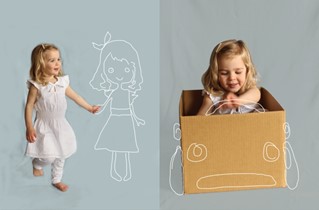The importance of tummy time

What's the big deal about tummy time and is it really necessary? Our experts give their best advice on what to do and how to do it
Despite all assurances that tummy time is fun, many infants seem to dislike being on their bellies on the floor, and wail, either straining to get up or face-planting on the mat. It's distressing to watch but there is hope if you are looking for ways to get your child into the swing of it. Tummy time is recommended at least once a day for developing neck and back muscles as well as reducing the flattening of the head, caused by babies sleeping on their backs. But not all child health experts are advocates of tummy time and it's not even essential that it happens on the floor.
In the words of a…Mother
Ngaire Angus
Ngaire Angus was keen to do everything right for her newborn daughter Geva (now nine months) and very aware that tummy time was an important part of an infant's routine.
From the time Geva was three weeks Ngaire was popping her on her tummy on the floor twice a day. There was just one problem - Geva hated it and would start to howl almost immediately. One minute on the floor seemed like 10 minutes.
"We were told even if it's just a little bit of time every day it's better than nothing. And we knew tummy time was good for strengthening the neck and back muscles but she seemed quite strong already."
Geva started rolling at about six weeks - partly to get out of tummy time, Ngaire suspects. Ngaire and her husband gave up on the floor tummy time after a month because it was all too hard. But they carried on doing tummy time with Geva on their own tummies when they were lying on the couch.
Then, when Geva was around four months, tummy floor time resumed and suddenly she didn't seem to mind. She now spends lots of time on the floor, rolling, sitting up (since five months old) and generally behaving like a happy, healthy baby.
"I don't really think that tummy time has been helpful or easy for her," says Ngaire. "My understanding was that tummy time was really good for strengthening the neck and shoulder muscles but I don't think it impacted on her strength at all. Her strength in the neck was pretty good. I'm not a believer that it's essential."
And leaving her baby on the floor to cry didn't fit with Ngaire's personal parenting style as she's always tried to be responsive to her baby's cues and, as a result, feels she has nice, clear communication with Geva.
However, she would probably persevere with it if she had another baby. "But maybe I wouldn't be so concerned if she wasn't doing it. Tummy time seems to be quite a big deal but next time I would be a lot more relaxed."
In the words of a…baby whisperer
Dorothy Waide
Mums often ask me about tummy time and I say the sooner you start with tummy time the quicker the baby will adapt. Tummy time is important as it helps to strengthen a baby's neck muscles and upper back. Some researchers say that it also gives babies a mental boost, encouraging babies to develop motor skills and aiding in their social development. It's rather like the increased mental wellbeing adults feel after physical exercise.
It is a great way for a baby to explore her surroundings and it teaches the gross motor skills of lifting and moving the head from side to side. While learning to lift the head, a baby is encouraged to stretch and reach out - the exact position from which she will learn to crawl.
Like anything in life, without regular practice it will take longer to develop the strength in the neck and shoulder muscles to lift the head. This could result in delayed development of other motor skills such as sitting, crawling and walking.
You can start with just a few seconds each time your baby is up from her nap. Once your baby show signs that she's had enough turn her over onto her back. If you start off with small time frames then over time you will find that your baby will start enjoying being on her tummy.
I often hear from mothers that their babies do not like lying on their tummies. My answer is that it is up to you to encourage your baby to enjoy it. Some of my favourite tips are as follows:
- Place a mirror on the floor in front of baby's face - this encourages her to lift her head and look at herself in the mirror.
- Board books placed in front of baby's face again encourages her to lift her head and look. In the early days, books with simple, bold black and white images work best at triggering interest.
- Musical toys in the same position will get your baby lifting her head to listen and look.
- Lie down face to face with baby. You can sing or talk to baby and again she will lift her head to gaze into your eyes.
But lying on a mat on the floor is not the only way to do tummy time. You can incorporate it in your daily routine of bathing, drying and dressing your baby. And this is especially important for babies who do not like lying on their tummies on the floor.
When drying a baby I pat dry her front and then turn her over to pat dry her back, neck, knee creases and back crease of the bottom. The added bonus of this is more tummy time.
Again, when dressing your baby if you need to do up snaps or buttons up the back of an outfit, turn her onto her tummy. It is much easier than trying to do it one-handed while holding the baby up in a sitting position - which I see many parents try, often resulting in an unhappy baby and a frustrated parent.
People ask me whether it is okay to put a baby with reflux on her tummy. My answer is yes. The baby may spill a little more but most babies with tummy issues love lying on their fronts.
It is also my favourite position for burping a baby. I tend to put her over my legs tummy side down and also over my shoulder. If she is a really difficult burper then tummy time on the floor can help with bringing up wind.
The most important point about tummy time is that it is a milestone and, as babies are individuals, they will do things in their own time. The key here as a parent or caregiver is to encourage, encourage and encourage, letting your baby do the rest.
In the words of an…osteopath
Nick Karuna, Wellbaby Specialist Osteopaths, Auckland
Tummy time guidelines recommend babies are placed on a firm surface, on their tummies for several minutes each day to strengthen the spinal muscles of the back and neck and developing the co-ordination of head movement.
However not all babies enjoy tummy time and may even find it distressing, leaving parents torn between responding to their babies' communication and wanting to support their babies' development.
We don't recommend persisting with tummy time when baby is distressed. A baby may have a good reason for disliking being placed on the tummy, and she needs a parent to listen to her. This situation can occur because of discomfort in the tummy, such as colic, or with neck pain from strains that can occur with birth. These are issues that an osteopath can help with, after which tummy time can be resumed if desired.
The development of babies' spinal muscles and control of head movement through tummy time is essential for the support of the basic functions of breathing, eating and motor skill development. A stable neck supports the functions of the throat area, maintaining clear airways and supporting chewing, swallowing and speech development. It also provides a stable base for organs such as the eyes and inner ears (essential for both gross and fine motor skills), as well as balance and hand-eye co-ordination.
Fortunately, the aims of tummy time are achieved in other positions. A baby lying on a reclining parent's chest is also able to lift her head and strengthen her back muscles; this position enhances tummy time with the stimulation of a parent's comforting presence. Babies who are carried in upright positions, either in the arms or in an inward-facing ergonomic sling or soft-structured carrier, are also achieving these aims. You need to ensure, though, that the carrier positions baby correctly and protects baby's developing hips and spine.
In ensuring babies' normal development we are not routinely required to "do" anything to them. A baby has an inherent knowledge of her natural development, she simply requires her parent to provide a safe environment so she can develop her natural movement patterns.
However, today's modern babies spend a lot of time in car seats and strollers, limiting their opportunities for free movement. So tummy time does allow opportunity for that movement.
But babies will naturally achieve time on their tummies themselves once they begin to roll from back to front at around four months of age.
The concept of tummy time was originally promoted as part of the "back to sleep" campaign recommending sleeping babies on their backs to help prevent SIDS. Tummy time was recommended to support safe sleeping and to avoid misshapen heads, positional plagiocephaly (flattening of the skull), from prolonged lying in one position.
While originally thought to be a cosmetic issue only, recent research indicates that plagiocephaly may be associated with delays in motor and cognitive functions.
Paediatric osteopaths frequently treat babies for head shape issues, as well as birth strains, sleeping, breastfeeding and digestive difficulties such as colic."
In the words of an…early childhood educator
Maureen Perry
Babies finding the tummy position is a critical milestone. Our focus is to begin by lying them on their backs and through a natural progression - back to side and then onto their tummies," says Maureen, who is a Resources for Infant Educarers (RIE) Associate and trained at the Pikler Institute, which supports freedom of movement and free play.
Maureen is one of a body of early childhood educators who don't advocate tummy time, although this goes against the current advice of other child health organisations.
Maureen recommends floor time for babies when they begin to be more wakeful and the back position is the most comfortable, allowing baby to move arms, legs and head freely. She says there's no need for adult intervention, such as tummy time.
Research carried out by Hungarian paediatrician Dr Emmi Pikler and published in Lass Mir Zeit(Give Me Time) with her daughter Anna Tardos in 1988, demonstrated that infants initially placed on their backs and allowed freedom to move independently, progressed to the tummy position at a similar age to babies who were assisted to reach this milestone. And the development of neck and shoulder muscles was achieved through this process.
Letting a baby move onto his tummy in his own time and his own way teaches self-reliance and self-confidence while strengthening their core muscles, says Maureen. Infants are innately motivated to move without the need for adults to place them in positions they can't get into or out of themselves, she adds.
"Infants move from the back to the side before turning onto the tummy. The side position is very valuable in terms of flexibility and balance. In my playgroup babies play comfortably on their sides using feet, hips and arms to support them while grasping and manipulating toys."
Placing babies on the floor on their backs gives them a chance to get to know their bodies, who they are and what they are capable of doing for themselves, while exploring the world around them. They will lift their legs, grab their feet and naturally turn to the side. When they see something that interests them it motivates them to move towards it by stretching and twisting. This is preparation for more advanced postures, she says.
"So when babies start to be awake more during the day, place them on a firm surface on their backs, so their heads can move freely from side to side and be with them on the floor, observing them and commenting on what you see them doing.
"At first they may play on their own for five or 10 minutes. However, when this floor time/play time becomes part of their daily routine they can and will play for longer periods, even half an hour or longer. This is their work - they are being given an opportunity to get to know how to be with themselves and what they can do.
"The early milestones - the back to the side to the tummy and to the back again provide the groundwork, a strong foundation for crawling, sitting, standing and walking."
Maureen suggests tummy time may have been introduced to counter the amount of time babies spend in "containers" today - from car seat to highchair to bouncer, exersaucer/swing.
"We're very busy people - these containers can make life easier for us and car seats are necessary to get around. However, our babies also need time to develop their strength, flexibility and balance and learn how to move their bodies.
"It's critical for their brain, concentration and their self-reliance."

AS FEATURED IN ISSUE 19 OF OHbaby! MAGAZINE. CHECK OUT OTHER ARTICLES IN THIS ISSUE BELOW

















